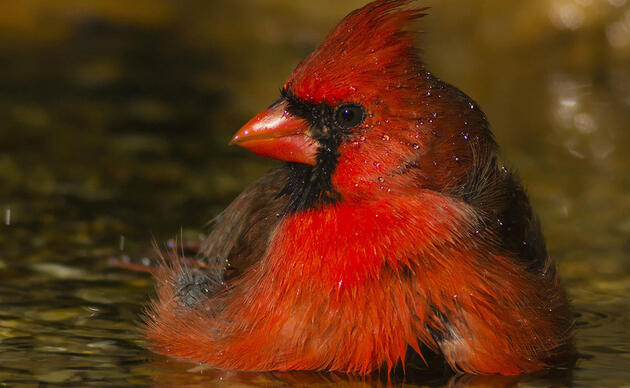Pat and Doris Leary are avid birdwatchers and citizen scientists from Fernandina Beach, FL, who volunteer their time and substantial skills to survey coastal waterbirds in Northeast Florida, coastal Georgia and Florida’s Big Bend. This is the fourth of several blogs in which they share their experiences and sightings, as well as the challenges these increasingly imperiled birds face.
A Saltmarsh Sparrow (Ammodramus caudacutus) banded as a nestling in the coastal marshes of far-distant New England was recently resighted in Nassau County's marshes. Scouting local marshes in preparation for a spring study of resident marsh breeding birds, Amy Schwarzer and Erin Ragheb of the FWC Wildlife Research Lab and I visited a number of sites. Large numbers of several bird species were found at most locations and such was the case at a small marsh island where we stopped for lunch. Erin searched with camera in hand and was able to photograph a briefly-sighted sparrow with a bright orange band. On a hunch, Erin later contacted Professor Brian Olsen, University of Maine, and was pleased to receive confirmation that the bird had been banded in either Maine or Connecticut as part of a multi-state population research study. The banding location is uncertain due to similarity of bands used on birds in both states.
This is the second, color-banded Saltmarsh Sparrow recorded in the region this year. The first was recaptured by
Alyssa Borowske, University of Connecticut, during her February 2013 field work in Florida. Alyssa's sparrow was traced to a breeding population in Maine. These sightings are remarkable due to the high number of birds dispersed across thousands of acres of Florida marsh, the sparrows' tendency to remain concealed, and the brief opportunity observers have to detect and record the tiny markers. In Alyssa's case she was fortunate to trap one banded bird amongst hundreds encountered during her field work here.
Northeast Florida’s coastal salt marshes support significant nesting populations of Seaside Sparrows and Marsh Wrens, but their numbers are substantially bolstered by an influx of migrant Seaside, Nelson's, and Saltmarsh Sparrows each fall and winter. Most originate from more northern Atlantic coast marshes, but some Nelson’s Sparrows breed in inland freshwater marshes hundreds of miles from the coast. In the winter, these species forage in the "drowned prairie" of coastal saltmarsh cordgrass and, despite their numbers, are seldom viewed by humans. On high tides, the birds concentrate in dense grass along marsh watercourses and on isolated marsh islands, but even there remain well concealed in vegetation.
Due to early evidence of sea level rise and related tidal perturbations, concern is growing for the survival of these species whose lives are directly dependent on the thin margin of tidal marsh stretching along the coast. Consequently, more attention is being focused on the status and health of these birds to identify important habitats and environmental requirements. As data is gathered, it is becoming evident that our regional marshes support not only significant numbers of resident sparrows, but also substantial populations of migrant and wintering birds.
The next time you gaze across our expansive marshes be aware that, in addition to the colorful Roseate Spoonbills, Wood Storks, herons, egrets, and the myriad of smaller shorebirds, the rich ecosystem also supports an abundance of marsh-adapted sparrows and wrens concealed from view in the dense stands of cord grass that are the key element in the ecosystem's fecundity. Stop, listen, and look carefully and you may catch a glimpse of these cryptically-colored birds that will give you a new awareness of the life within Florida’s coastal saltmarshes.
By Marianne Korosy
Stay in Touch!
Show your love of birds today. Subscribe to receive email updates about Audubon's conservation work and hear about opportunities to help birds in your area or nationwide.




